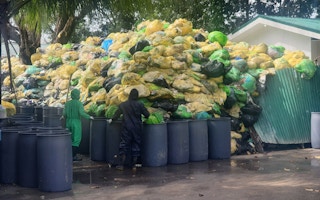The Philippines’ Covid-19 waste problem has once again been brought to the fore after piles of medical waste sitting in a compound of a local hospital drew flak from nearby residents.
To continue reading, subscribe to Eco‑Business.
There's something for everyone. We offer a range of subscription plans.
- Access our stories and receive our Insights Weekly newsletter with the free EB Member plan.
- Unlock unlimited access to our content and archive with EB Circle.
- Publish your content with EB Premium.
More than 234,000 metric tonnes (MT) of healthcare waste, equivalent to about 6,000 trucks, was generated in the country from June 2021 to the end of January this year, but only 16.6 per cent of it has been transported to the waste treatment facility, and 13 per cent reported as treated, according to latest government data.
“Measures to mitigate the spread of the virus created an increased demand for personal protective equipment (PPE). While they may have helped to contain the virus, they may also have contributed to the increase in healthcare wastes globally and locally,” said Healthcare without Harm (HCWH), a United States-based non-governmental organisation that works to reduce the environmental footprint of healthcare worldwide for hospitals to curb their waste during the pandemic.
The illegal dumping of pathogenic waste was recorded elsewhere in the country early this year, resulting in children getting infected by Covid because of it.
The Quezon Medical Center in the province of Lucena, Quezon, about a hundred kilometres south of capital city Metro Manila, has had some 100 tonnes of hazardous medical waste accumulating in its vicinity in the past three months.
They were not discarded because of the hospital’s inability to sustain the disposal process amid the surge of hazardous hospital waste at the peak of Covid-19 admissions in the latter part of last year, said Dr. Rolando Padre, director of Quezon Medical Center.
Padre said they had difficulties in paying fees to contractors during the last quarter of 2021 because of the non-passage of the annual budget of the provincial government, containing its Covid-19 response fund.
The fund includes allocations to public hospitals like Quezon Medical Centre, which rely on the government to help alleviate costs borne out of the pandemic. These budget allocations are needed for the construction of isolation wards, the procurement of vaccine boosters, as well as the treatment of Covid-19 medical waste.
Although Quezon Medical Centre‘s staff has started storing the toxic garbage in 80 containers to be sent to the city’s treatment facility this week, it was done only after mounting complaints of foul odour and sanitary concerns from residential areas surrounding the hospital.
The government has mandated hospitals to be responsible for enlisting their own service providers, who will haul their medical waste to temporary storage areas like warehouses, before it is brought to a contracted treatment, storage and disposal (TSD) facility.
Medical waste in the country is typically sterilised by steam, also known as autoclave, which subjects the waste to intense heat and pressure to kill pathogens prior to disposal in a landfill.
“If a hospital cannot afford the treatment of their waste, then they should not do their business here. Our policy requires a hospital waste generator to treat their own waste and dispose of it properly,” Jonas Leones, undersecretary for the Department of Environment and Natural Resources (DENR), told Eco-Business.
Leones added that TSD facilities can accommodate 103,000MT of waste per day, much more than the daily average of waste generated at about 1,000MT daily. He noted that the government is building 300 new sanitary landfills nationwide which will be completed within the year to help ease pressure on the existing ones.
The challenge of medical waste management lies in the collection and transport of the wastes to treatment facilities which the agency is now addressing, he said.
Central Luzon, where many of the country’s urban centres are, can handle the increased volume of medical and infectious waste. A bulk of the country’s 135 registered TSD facilities are found in Metro Manila and nearby provinces like Pampanga and Bulacan, while there are none in those further away from the capital like Bicol, Cagayan Valley in Luzon, and Zamboanga in Mindanao.
Leones said that capital will be allocated to some local governments in the Philippines to construct waste treatment facilities.
From incineration to reducing use of gloves
Incineration of medical waste is another option to discard medical waste, but it is currently moot in the Philippines, where burning waste is outlawed under the country’s Clean Air Act.
The DENR and a local senator have pushed for the incineration of medical wastes that have accumulated during the pandemic, amid criticism from activists who say it is a violation of the regulation and will only worsen air pollution.
Others are advocating using fewer resources to bring down the levels of waste. HCWH found in its study released in November that 48.6 per cent of hazardous medical waste in the Philippines consisted of medical gloves which were used by health practitioners as part of their PPE worn mostly in the emergency room and intensive care unit.
A campaign by the United Kingdom’s National Health Service system, addressing the over-use of non-sterile gloves, could be replicated in the Philippines. The drive pushed for gloves to only be used by health professionals when they are likely to touch blood, bodily fluids or mucous membranes. The initiative saved over a million dollars in a London hospital and prevented 18 tonnes of waste being sent to landfill in its first year.










